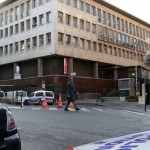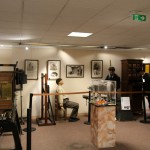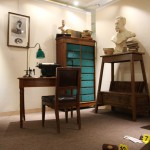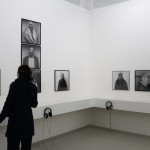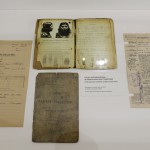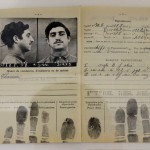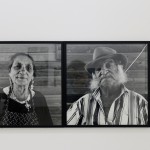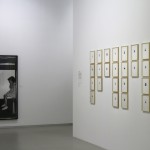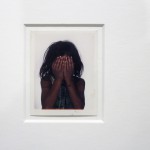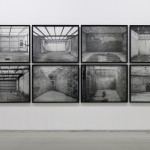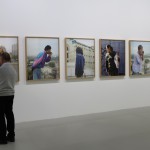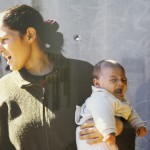I found that beautiful early film about resistance to a mugh shot: „A Subject for the Rogue’s Gallery“ (1904) American Biograph Company; cameraman/director A.E. Weed.
Schlagwort-Archive: mug shot
Recording Race: Huxley
Recording Race: T. H. Huxley’s Photographic Survey of the Races of the British Empire. Research visit to the „Thomas Henry Huxley Papers“, Imperial College London, April 2015.
It is certainly not easy to get an appointment at the archives of Imperial College London, where the “Thomas Henry Huxley Papers” are kept. This is the only archive I have encountered so far that would make a letter of intent, a project description, as well as a letter from my supervisor and university a prerequisite for consulting the materials. However, after settling all those issues, I am received cordially and a seat and research aids have been prepared for me.
Thomas Henry Huxley was a traveler, biologist and educational reformer, he is however best known as an important advocate of Darwin’s theory of evolution. He shared a circle of friends with Charles Darwin, Herbert Spencer and Francis Galton, with whom he exchanged letters that are kept in the archive. For instance in a letter dated October 16th, 1886, Francis Galton asks Huxley’s opinion on the biographies of Erasmus Darwin and Charles Darwin in relation to a proposal for a monument.
Races of the Empire
I am, however, particularly interested in his project of a visual survey of the ‘races’ of the British Empire, that was launched in 1869, and for which Huxley developed a anthropometrical photographic standard for the depiction the human body. The plan originated in the Ethnological Society of which Huxley was president, and which sought to improve the quality of data in the field and establish a scientific classification of the ‘races’ of the British Empire. The project however was administered by the Colonial Office in London that sent out an official request to the colonial administrations and forwarded the material, photographs and letters, to Huxley. Even though the material that he received was never used in his publications or in the work of the Ethnological Society, the portraits represent an important, if problematic, insight into the practices of scientific photographic depiction of the human body and in particular of colonial subjects. Recording Race: Huxley weiterlesen
Bertillon Exhibited
Research trip to the „Musée de la Préfecture de Police“ in Paris/France, January 2015
The museum of the police prefecture of Paris is located in the centre of town. It is only a five minute walk from the “Ile de la Cité”, the central court of Paris and the historical Prefecture where in nineteenth century Alphonse Bertillon resided in the upper stories as the head of the department of judiciary identification. The museum is however not housed equally grandiose, but in the third storey of a post-war concrete building. Already in the forecourt a sombre looking police officer blocks my way, the secret parole “museum” changes his expression and he leads me through a door. Here again, in a dark waiting room, ripe with the smell of the self-service coffee machine, faded posters of police announcements and wanted posters, I am lost. Another obstacle, this time a desk manned by a team of officers, has to be overcome before I am granted access to the elevator.
Right opposite of the entrance door to the museum there’s a section on the “Scientific Police”, mainly on Bertillon’s work. An accumulation of framed photographs and texts as well as objects introduces the development of identification and scientific police work. Among these are reproductions of historical photographs, of the process of taking anthropometric measurements, the archive of the Bertillonage records, tables for the portrait parlé, as well as crime scene photographs and reproductions of fingerprints. A huge enlarger takes up much of the space, but leaves room for a staged photo shooting – wooden posing chair and historical camera. Two puppets are representing a seated suspect under the gaze of a photographer whose face is clearly modelled on Bertillon – here he is the “Father of Scientific Detection” standing right in front of me, but slightly stiff. Another puppet operates a small wooden ordering cabinet for the Bertillonage identification cards, as it was used in the introductory phase of the new technique of biometric identification. By the beginning of the twentieth century, the records filled endless rows of shelves in the former police archive and a team of clerks were employed to order and retrieve the identification cards. Some of the cards and judiciary photographs are now kept in the archive of the Police Prefecture that I could visit on my last trip to Paris. In a corner a suitcase of instruments for taking the eleven anthropometric measurements of the Bertillonage rests in a vitrine.
When I arrive at the museum for a second time and ask for an appointment with a curator, the staff leads me into a small office. Even though my earlier message apparently didn’t reach her the woman greets me enthusiastically, as if she’d expected me. The room is overflowing with papers, boxes, objects – like tidal waves this ocean crashes onto her table. Bertillon Exhibited weiterlesen
Ambiguities & Asymmetries
“Ambiguities & Asymmetries”, Review of the SSN Conference, Barcelona, 2014
The bi-annual conference of the Surveillance Studies Network 2014 takes place in the centre of Barcelona, on the campus of the University of Barcelona and the adjoining cultural institution CCCB. This year’s conference’s topic opens the floor to discussions of “Asymmetries and Ambiguities” in Surveillance Studies. The attention for the conference is unusual, not only in academia, as it becomes obvious in the comparably large number of 170 participants, but also in exceptional public and media attention. This surely has to do with the revelations of Edward Snowden and the so-called NSA scandal, which have proved true or surpassed the often dismissed observations of the surveillance studies community. Here especially “asymmetries” come to the fore: between an all-encompassing state-run surveillance assemblage, drawing on private sources, on the one side and disempowered individuals on the other.
In the evening panel discussion (videos available online) with Caspar Bowden (a privacy advocate and former Microsoft executive), Katarzyna Szymielewicz (human rights lawyer, Panoptykon Foundation), and Ben Wizner (Snowden’s lawyer) who is participating via video connection, these asymmetries become apparent. Ambiguities & Asymmetries weiterlesen
Archives de la Préfecture de Police de Paris
Research visit to the „Archives de la Préfecture de Police de Paris“
During my visit to the „Archives de la Préfecture de Police de Paris“, in February and March 2014, I am examining the material related to the work of Alphonse Bertillon, who is described as a protagonist of scientific police work and the founder of modern identification. Drawing on insights from social statistics and studies in human physiognomy, he developed a system of identification based on anthropometric measurement, additional descriptions and photography. I am here to look at his utilisation and development of the then still young medium of visual recording. In relation to my PhD. Project, especially his practice of depicting the face in the systematic frontal and lateral judiciary portrait and the technique of dissecting and re-composition of the human face in the “portrait parlé”, the verbal portrait, is relevant. Furthermore I am here to explore the connections between the modes of depiction in Francis Galton’s composite portrait and the recording and decoding of the criminal face as proposed by Alphonse Bertillon.
I am pushed to daylight by an escalator at the Station “Hoche” in the north-western outskirts of Paris. An overpowering smell of food and rotten fruit is in the air. On my way to the archive, I walk through a slightly run-down neighborhood, past an outdoor marked, a neglected shopping centre, take away restaurants. The archive has just recently moved here from the city centre, where it was housed in the buildings of the Police Prefecture. The new location is set back behind a green fence, only a small sign indicating that this seemingly small structure contains this huge historical archive. After the registration process, in which I am provided with an identification card, I am sent through a back door to meet the responsible persons for the photographic archive. A middle aged woman and an older man show me five folders full of paper photographs and reproductions, filed under the name Alphonse Bertillon and the headers “Identification Judiciaire” and “Affaires Criminelles”. While the latter include material on individual criminal cases, the former are those I am looking for. Archives de la Préfecture de Police de Paris weiterlesen
Out of Control?
21. 03. – 24. 08.2014 – “Out of Control? Life in a World under Surveillance.” Exhibition, Museum for Communication Berlin.
Do we life safely when squares, streets and buildings are monitored by surveillance cameras, when secret services scan all kinds of communication? Does it make things easier when software proposes our next moves? Are security and freedom compatible under these circumstances?“ The exhibition shows over 200 historical exhibits, ranging from 19th century albums of mug shots to Stasi observation equipment, as well as contemporary technologies of surveillance and control. The technical exhibits are complemented by artistic works that make surveillance surroundings perceptible, raise awareness of the phenomenon, but also offer the possibility to laugh. Artistic works by Adam Harvey, Timo Toots, Raul Gschrey and others.
Mug shots & Burning Caravans
Review of the exhibition „La Traversée“ by Mathieu Pernot in the „Jeu de Paume”, Paris, March 2014.
The exhibition „La Traversée“ by Mathieu Pernot in the „Jeu de Paume“, Paris opens with a wall of photographic portraits: small and large-scale, colour and black and white. The subject of all images is a boy turning into a man over the time, offering glimpses into his life. The portraits of the Roma individual set the tone for an examination of concepts of sedentary and nomadic living life.
Entering the exhibition space, in a niche on the left hand side, a work compiled from historical identification documents, interviews and photographic portraits shows how non-conform, nomadic behavior was restricted through heavy police pressure far into the 20th century. The personal stories and artistic portraits contradict the externally prescribed identity in the signaletic cards and nomadic passes.
In another work, on an adjoining wall, the historical mug shots and documents are contrasted with a series of photo-machine portraits that the artist produced with the children of the Roma family he is working with since his university days. The self-portraits hint at the ongoing administrative pressure directed against the non-sedentary population.
This is not restricted to the distant past as a series of large scale photographs of today’s disciplinary institutions, prison yards illustrate. A series of portraits shows family members trying to communicate with the inmates beyond the high walls. These state institutions still extend their influence in an extraordinary manner on the non-sedentary population.
In the next part of the exhibition, this apparatus of identification and population management meets images of sedentary life in the 20th century, concrete housing structures, their de-individualising character, but also their increasing disappearance as overcome and no longer acceptable spaces for residence.
Photographs of a burning caravan and alighted faces of a group of onlookers terminate this circle of a description of society that goes way beyond the documentary realm. Mathieu Pernot is mixing and composing, comparing and opposing story threats and offers new perspectives on – and readings of – our pre-structured and often unquestioned realities of contemporary life and questionable strategies of upholding this status quo.
Identifying Identity?
“Identifying Identity? Identification and Typification in 19th Century and the Formation of 21st Century Identities.”
Presentation at the conference “W(h)ither Identity – Positioning the Self and Transforming the Social” at the GCSC, Giessen University.
19th century endeavours of identification and typification, among others by the French criminologist Alphonse Bertillon, have provided the basis for today’s intricate and interconnected collections of data on individuals – their body and face. It is difficult to overestimate the importance of their work widely influenced today’s means and practices of biometric identification as well as contemporary identity formation.
Taking portraits from the early days of photography as a starting point, the paper will examine the genesis of the practices and modes of visual representation and provide an outlook on contemporary digital archives of personal visual data. Here the ambivalent role of the portrait becomes obvious: on the one hand as a sign of voluntary and confident self-representation of for the first time large parts of society in the 19th century, on the other hand as a means of forced external ascription in practices of identification through the mug shot in police work. This technique of recording the criminal face is eventually extended to cover the whole population in IDs and administrative archives. These processes of visual development have gained new momentum through techniques of computerisation and automation in biometric identification that have just in recent years changed the pictures on our passports from smiling half-lateral portrait to frontal expressionless mug shot.



